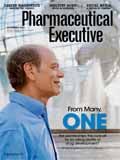Rebates and Reform
Pharmaceutical Executive
User-fee renewal legislation sets the stage for new policies affecting reimbursement, research, and regulatory oversight.
The push has begun for new policies to "improve" the drug approval process as all sides gear up to reauthorize prescription drug user fees next year. There's much talk about spurring biopharmaceutical innovation, but industry fears that cost-cutting efforts by the Obama Administration and Congress will curb resources for the FDA and further squeeze drug reimbursement.

Jill Wechsler
After a year of consultation with all parties, regulators and manufacturers reached agreement for renewing the Prescription Drug User Fee Act (PDUFA) this past spring, on track to transmit the plan to Congress next January. The current user fee program expires September 30, 2012, and a new program has to be in place before then for FDA to be able to continue collecting industry payments, which now support some 60 percent of the cost of assessing new drugs and biologics.
Fighting Rebates
One of the most contentious proposals is to impose price controls on Medicare drug benefits, here in the guise of rebates on Part D drugs, specifically those medicines consumed by low-income seniors who previously obtained drugs from state Medicaid programs that negotiate rebates with manufacturers. The shift of those "dual eligibles" to Part D plans eliminated some of those rebates, and industry critics led by Rep. Henry Waxman (D-Calif.) have been pressing to recoup this pharma "windfall" for several years.
The Congressional Budget Office (CBO) estimates that rebates on drugs for some 10 million seniors who receive low-income subsidies under Part D would save $112 billion over the next decade, or $10 billion a year. That's too big a number for the budget-cutters to ignore.
John Castellani, president of the Pharmaceutical Research and Manufactures of America (PhRMA), is fighting rebates with data showing that such a policy will prompt biopharmaceutical companies to shift operations—and US jobs—overseas. A Battelle study for PhRMA calculates that a $10 billion hit on industry revenues would kill 130,000 high-paying jobs—not good for reducing unemployment.
At a press briefing in July, Castellani explained how the biopharmaceutical industry has thrived in the US due to pro-innovation policies. Now the Europeans are offering incentives to get this industry back, while Singapore and other emerging economies have identified pharma as critical to their economies. Merck president Kenneth Frazier similarly observed in a Wall Street Journal op-ed (July 13) that the designation of the US as the "medicine chest to the world" will be undermined if the federal government imposes price controls on Part D and establishes the Independent Payment Advisory Board (IPAB; see sidebar).

Down with IPAB
The rebate plan, moreover, could destabilize Part D, which has been a huge success in cutting the cost of medicines for seniors during 2006 to 2010, according to another report for PhRMA by the IMS Institute for Healthcare Informatics. At the same time, CBO calculates that the total cost of Part D is 41 percent less than its initial estimates, partly because plans have negotiated hefty discounts from manufacturers. Most important, increased use of prescription drugs due to Part D significantly reduced Medicare spending on hospital and nursing home care, reports a separate study published in the Journal of the American Medical Association (July 27).
PDUFA Christmas Tree
If a Part D rebate requirement is not part of a broader deficit control measure this year, it's sure to be on the growing list of pet programs that legislators hope to hang on the user-fee "Christmas tree." Pharma critics also seek bills to legitimize drug reimportation, reduce biosimilar exclusivity, curb brand/generic patent settlements, and extend 340B discounts for drugs used by safety-net hospitals to inpatient use and orphan medicines.
Pharma companies have their own preferences, such as added incentives for developing new antibiotics and an update for FDA's orphan drug program. Industry supports drug safety legislation, but wants a say in provisions for mandating drug recalls and enhancing import controls. There's also interest in making REMS less burdensome and in revising FDA conflict-of-interest policies that exclude many qualified experts from seats on FDA advisory committees.
A Biotechnology Industry Organization (BIO) wish-list is less conventional, calling for FDA to become an independent agency and to de-politicize it by appointing the FDA commissioner to a fixed six-year term. BIO wants to require FDA to tell sponsors specifically why it's not approving an application and proposes a "progressive" drug approval procedure that permits therapies for diseases that lack effective treatment to come to market on a limited basis while the sponsor completes clinical studies.
The basic PDUFA proposal is not radically different from the current fee program and thus by itself should win Congressional support fairly easily. FDA is looking to boost user-fee revenue by a "modest" 6 percent a year, to about $700 million in fiscal year 2013. Most notably, FDA gets an extra two months to review applications; the official review clock won't begin until after a 60-day "administrative filing period" following application submission. PDUFA V also will support more reviewer/sponsor meetings and a new cadre of FDA liaison officials to enhance communications. FDA will assess meta-analysis methods, biomarkers, and patient-reported outcomes measures; boost its Sentinel system to improve post-market drug safety surveillance; and establish an electronic submissions system for clinical data, something that has been in the works for years.
Along with PDUFA, FDA and manufacturers are working on a new user-fee program for generic drugs, while also discussing a fee formula for biosimilar product applications. And there's strong support for renewing pediatric drug development and research incentives, preferably on a permanent basis.
The Medical Device User Fee Act (MDUFA) also is up for renewal. Negotiations on that program have been much more contentious than for drugs, as FDA weighs options for overhauling its 510k regulatory process for low-risk devices, which has device makers up in arms.
Congress launched its formal assessment of PDUFA issues at hearings in July. Commissioner Margaret Hamburg outlined for the Senate Health, Education, Labor, and Pensions (HELP) Committee how user fees enhance patient access to medical products. While most Senators backed user-fee renewal, Sen. Richard Burr (R-NC) threatened to block PDUFA reauthorization if FDA doesn't speed up approvals for medical devices.
At a hearing before the House Energy & Commerce health subcommittee, E&C chairman Fred Upton (R-Mich.) laid out prime Republican concerns: REMS requirements may be thwarting new drug development, and "rigid and unrealistic" conflict-of-interest policies keep top scientists off advisory committees, preventing these panels from vetting new drug candidates in a timely manner. Janet Woodcock, director of the Center for Drug Evaluation and Research (CDER), provided a fairly positive report on FDA's drug approval process, describing how proposed PDUFA V enhancements will further address access and safety issues. Woodcock was able to report that FDA was on track to approve more drugs in 2011 than in recent years, with 20 new drugs already okayed at mid-year—almost as many as in all of 2010. She also noted that CDER's rate of first-cycle approvals for priority new molecular entities (NMEs) is going up, and that the agency was approving important innovative therapies, such as treatments for hepatitis C and for late-stage melanoma.
The real problem, she said, is not slow approvals, but that too many experimental drugs continue to fail during development. PDUFA can improve the process by supporting FDA science and research needs, as outlined in a July report from CDER's Science Prioritization and Review Committee, which describes opportunities to improve analysis of post-market data, product quality assessment, clinical trial design, and individualized treatments.
Jill Wechsler is Pharmaceutical Executive's Washington correspondent. She can be reached at jwechsler@advanstar.com

Navigating Distrust: Pharma in the Age of Social Media
February 18th 2025Ian Baer, Founder and CEO of Sooth, discusses how the growing distrust in social media will impact industry marketing strategies and the relationships between pharmaceutical companies and the patients they aim to serve. He also explains dark social, how to combat misinformation, closing the trust gap, and more.
Pfizer, GSK Gain ACIP Recommendations for RSV and Meningococcal Vaccines
April 18th 2025The Centers for Disease Control and Prevention’s Advisory Committee on Immunization Practices voted to expand access to Pfizer’s respiratory syncytial virus vaccine Abrysvo for high-risk adults in their 50s and voted in favor of GSK’s meningococcal vaccine, Penmenvy, for streamlined adolescent protection.